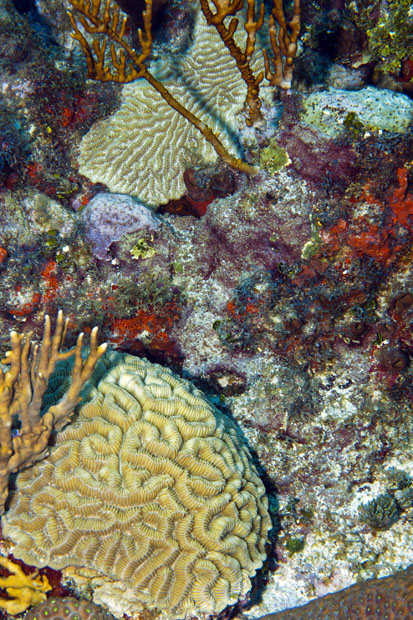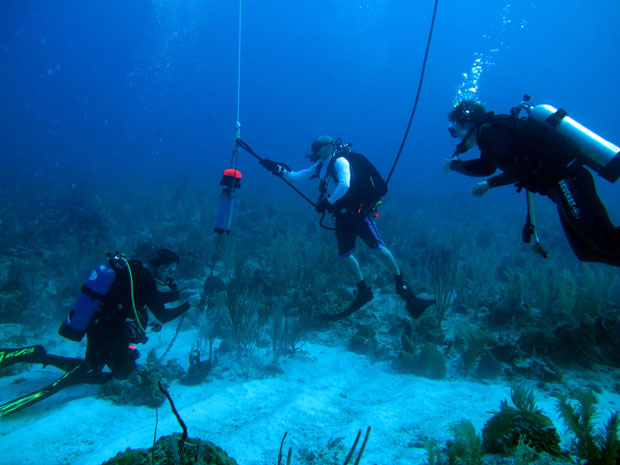Whitecaps are never good news when you’re diving. Sure enough, the swell and breeze both grew overnight, though luckily not too big to take the Calcutta out. After a late start for some repairs, the dive boat brought the group to the first site of the day. Under a merciless sun, everyone was happy to get in the water and set about their various tasks.
Brian Beck and CAPT Phil Renaud paired off to do transects: coral and photographic, respectively. Brian laid out a weighted 10-meter line on the bottom and proceeded to record every coral species for half a meter on either side, a slow, meticulous task that took the entire dive. Phil followed his own 10-meter line, taking high-resolution, digital photos of every square meter.
Back on the ship, these photos will be analyzed using an open-source program called Coral Point Count with Excel extension or CPCe. This gives you statistics on how much of the bottom each coral species (or whatever else you want to record) covers. It scatters any number of points on each photo, which you then have to tag as being a particular species of coral, healthy or not, or any other variable you want to record. It can take a long time — graduate school and internships involve a lot of this sort of work.
On his dive, Ken Marks spotted a species of coral that had just been described as new last November. Meandrina jacksoni is a hermatypic (stony) coral, meaning it helps build reefs with its calcium skeleton, as opposed to soft-bodies corals, which don’t. It looks a lot like Meandrina meandrites, the species it was originally lumped under, but its “brain” pattern has smaller ridges and whitish valleys. There are less than 100 hermatypic species in the Caribbean, so it’s a reef scientist’s dream to identify a new one.

New technologies, like DNA analysis, have made taxonomy (the science of identifying and naming new species) a much more exact science, though not always simpler. The only way researchers used to be able to tell species apart was by measuring things like physical features and geographical ranges, which left room for interpretation and argument. (Is that handful of birds with slightly longer beaks a different species or just outliers?) Molecular phylogenetic techniques (mostly DNA analysis) can now show exactly how closely related organisms are or aren’t, but they’ve also introduced new puzzles like cryptic species, which can look exactly the same but be genetically distinct.
The crew had lunch on the boat, or at least those with settled stomachs did, and we started motoring to the second site on the edge of the bank, estimating about a half-hour trip. Alas, the swells were too big; the smaller tender boat trailing behind was almost launched into the air more than a few times, so we settled on a closer alternate spot. Since it was deeper, about 24 m (80 ft), 26 minutes of bottom time was the limit for the afternoon dive.
Brian, Phil and Nick spent the dive lowering the AAnderaa RDCP600 Current Profiler to the bottom. It’s a two-foot blue cylinder about as big around as a coffee can, with three Doppler sonar heads at one end. With the heads pointing up, it can measure the currents in the entire water column above it, including how strong they are and which direction they’re going in. Other sensors can measure things like turbidity (water clarity), dissolved oxygen, conductivity (basically salinity) and temperature.

The current sensor goes down at every site the Golden Shadow visits. Currents are important in reef ecology because they bring in things like cool water, oxygen, plankton and nutrients, and carry larvae in and out of a site. With climate change, cool currents are even more important, acting like natural air conditioners to modulate temperature changes and keep reefs from overheating. Reefs in areas with good currents tend to bleach less. (They may be a resilience factor, in other words.) Currents also affect where coral grow: soft corals tend to grow where there are faster currents, such as on the windward side of an island, since it helps them feed.
After making sure the current sensor was solidly in place, suspended between two 35-pound anchors and a yellow buoy, we explored a bit and found a six-foot-plus nurse shark (Ginglymostoma cirratum) resting on the sand nearby. Not all sharks have to swim to breathe; this nocturnal species can get enough oxygen by pumping water over its gills while lying stationary on the bottom. Here’s a video we caught of the nurse shark: http://www.youtube.com/watch?v=pf4ERkcRH9o
They may look docile while they’re “sleeping” by day, but nurse sharks have been known to latch on to bothersome divers like a pit bull and roll like a crocodile — not a situation you want to be in 80 feet down. They can feed by sucking water into their mouths. Juveniles will sometimes prop themselves up on their pectoral fins and wait for a crab to come looking for shelter. What looks like a little cave turns out to be a shark’s shadow and the crab gets vacuumed up before it knows what hit it.
As soon as it realized we were there, the shark roused itself and swam off, in no particular hurry.
(Photos/Images by: 1 Ken Marks, 2-3 Brian Beck)
To follow along and see more photos, please visit us on Facebook! You can also follow the expedition on our Global Reef Expedition page, where there is more information about our research and team members.